Cost Of Dental Implants
The Cost of Dental Implants - Why are Teeth Implants so expensive?
When you have a missing tooth or missing teeth, dental implants are one of the options to fill that gap. Other options for replacement teeth include a dental bridge (fixed partial dentures), or removable dentures. BUT, dental implants cost more than ALL the other alternatives for replacing a missing tooth.
The all-up figure to have a tooth replaced by a single dental implant starts at around USD2,000 and can go all the way up to USD5,000. For ONE tooth.
Having the protection of health insurance can help with some of these expenses, but a lot of times the cost of major dental work will still fall to the insured. There are two main reasons why the cost of dental implants is so high.
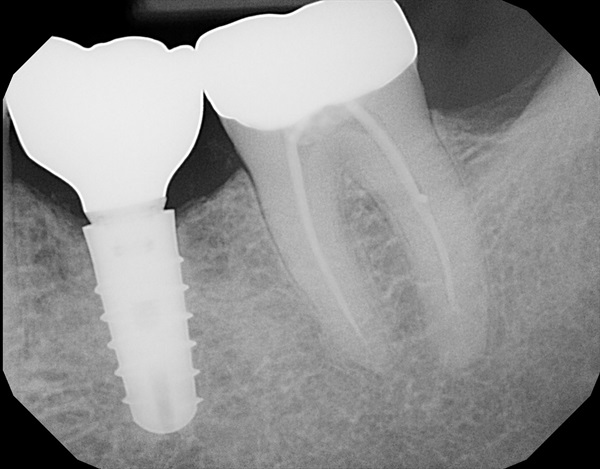 A dental implant next to a natural tooth
A dental implant next to a natural toothFirst, dental implant treatment takes a LOT of time! This is your dentist's time - more appointments are needed than for, say, a normal fixed bridge. A lot of this time is taken up before you even have any implant surgery, by planning, and trying to anticipate potential dental implant problems.
The surgical procedure to place a dental implant is complex and time-consuming, and is akin to orthopedic surgery on a much smaller scale, on a conscious patient, in a difficult environment - the mouth. Dentists need extra training to learn how to carry out implant surgery safely and predictably. Sometimes an oral surgeon will need to get involved, if there has been a lot of bone loss in the area where the implant needs to go.
AND THEN after dental implant surgery, you need several follow-up appointments with your dentist, to check on the healing process and make sure everything is going to plan. And we haven't even got to putting a dental crown or fixed bridge on the implant yet!
Cost Of Dental Implant
- Types of Implant
The different types of dental implants can appear confusing at first. For a start, there are many different dental implant manufacturers, each with their own design.
And then there are several types of implant technique - (how the implant is positioned, and how it is fixed to the jaw bone). And finally there are different types of implant materials. Which implant your dentist recommends depends of a number of things, such as how many missing teeth you want to replace, your overall oral health, and degree of bone loss following tooth extraction.
First; what about all the different dental implant manufacturers these days? The market for dental implants has boomed over the last 20 years, and new companies are appearing all the time, offering new designs. (You can read more about this at my page on the best dental implants).
But don't worry - all types of dental implant have to be approved by the health authorities in the country they are sold in (for example, the FDA in the USA), and they all have to meet stringent health requirements.
So the exact manufacturer name doesn't really matter too much. Of course, some implant manufacturers have been around a lot longer than others, and have a longer track record of success. Most dentists will prefer to stick to the big, established manufacturers.
So, don't worry about which make of implant you might be getting - trust your dentist to use the one he's most comfortable with!
Next, you might wonder about the actual material that a dental implant is made of.
All types of dental implant use only 1 of 2 materials.
The most popular material by far is surgical-grade titanium. The other option is a type of ceramic called Zirconia. What's the difference? Titanium is the original material used for dental implants. It has several properties that make it almost ideal;
- It is extremely strong.
- It is non-toxic.
- And most importantly, human bone will grow right up against it, even into microscopic pits on the surface of the implant. Dentists call this process "osseointegration". It means that the titanium dental implant will become fused to the jaw bone after the healing period (about 3 months).
What about Zirconia? This is a very special material - half metal, half glass. It has the nickname "ceramic steel". It has 2 main advantages over titanium.
- First, it is tooth-colored, which means you are less likely to get a grey shadow under the gum edge, which sometimes happens with titanium implants after a few years.
- Also, it is metal-free. This means that it doesn't release any metal particles into your body - a small concern for some people with titanium implants.
But there are some concerns about the strength of Zirconia over time. This potential problem has largely been fixed now, but many dentists are still shy about using Zirconia types of dental implant, until we have more years of evidence.
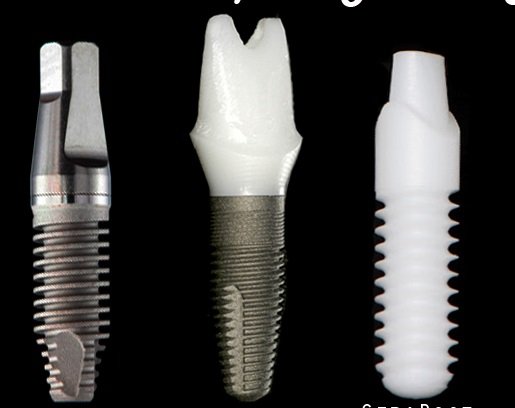 A Zirconia implant on the right
A Zirconia implant on the rightThe other thing about Zirconia is that, although it is bio-compatible with the human body, it doesn't get the same degree of osseointegration as titanium. This means that it doesn't become quite as firmly fixed in your jaw bone after the healing period.
FINALLY, we come to the different dental implant techniques.
There are basically TWO main types of dental implant.
- Endosteal. This implants go into your jaw bone where the tooth roots used to be. In this group there are 3 sub-types;
1. Root-form implants, about the size and shape of a natural tooth root.This by far the most common type of dental implant, and may be made from titanium or zirconia. These are mostly used as single dental implants, to replace a single missing tooth.
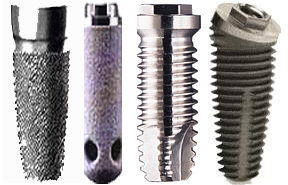 Four root form titanium dental implants
Four root form titanium dental implants2. Mini-dental implants. These are "almost" root form implants, but are MUCH narrower and also shorter than standard root-form implants. They are useful in situations where you have a small jaw bone, and there isn't much bone to hold a conventional implant. The downside is that, because they are small, they can't take as much weight as normal implants, so you need more of them.
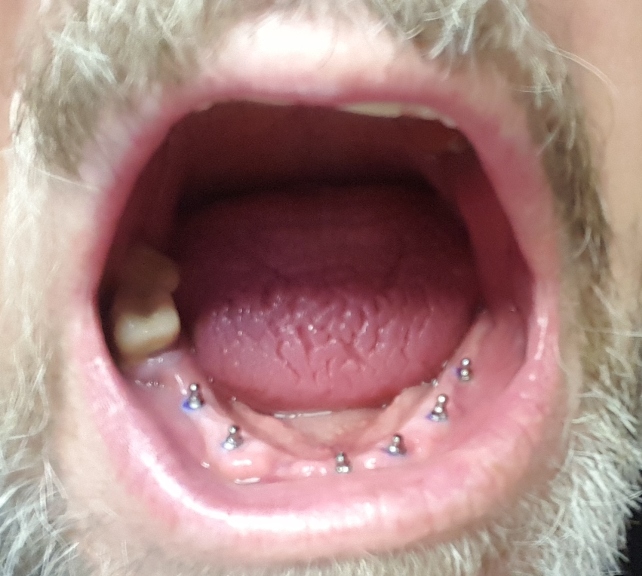 Six mini implants in the lower jaw
Six mini implants in the lower jaw3. Blade implants. These are less common than they used to be, but may still be useful where the jaw bone is very narrow. See down the page for more information on these different types of dental implant.
 A Blade implant supporting a bridge
A Blade implant supporting a bridgeSub-periosteal. This type of implant does not go into the jaw bone, but it sits in top of the jaw bone, under the gum. The gum has to be lifted (under anesthetic) to allow the implant framework to be fittd over the bone. The gum is then stitched back into place, and it heals up to hold the implant firmly in place. More details below.
Cost Of of Dental Implants
- More detail
1. Root-form dental implant.
The most common technique is to use a dental implant that is shaped approximately like a tooth root. It is roughly the same length and thickness as a tooth root, although some may be longer, and some may be shorter, depending on how much jaw bone is available in the spot you want the implant to go.
This type of dental implant is called a "root form implant", because it is about the shape and size of a tooth root.
Technically, it is called an endosteal implant or an endosseous implant. This is just medical jargon for something that goes into the jaw bone. It is positioned where the missing tooth root used to be, in line with the tooth roots either side of the gap. A single implant can replace one missing tooth.
A root form implant also has a screw thread on it, and it is gently screwed into the jaw bone, until it is just level with the gum, or even slightly below gum level.
Then the gum is stitched over the top for a few months until the implant has healed into place - become fused to your jaw bone by osseointegration. Obviously, this type of dental implant needs enough depth of bone to give it adequate support.
If your jaw bone has shrunk down (bone loss) due to gum disease or simply from the passage of time, you have 2 options; your dentist may be able to build up the jaw bone with a bone graft, OR he may recommend a different type of dental implant, especially if the aim of the implant treatment is to anchor down a full denture.
All on 4 dental implants.
When writing about the different types of dental implant, I feel I also have to mention the All on 4 dental implant technique, because many people ask me about it. Actually, it's just a variation of the root form dental implant method, because it uses those implants. The term All On 4 refers to having all the replacement teeth in one jaw (top or bottom) supported by just 4 implants, are an alternative to traditional dentures.
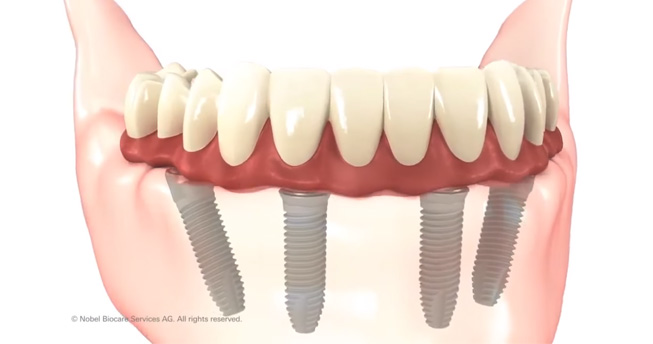 All on 4 dental implants
All on 4 dental implantsThe root form dental implants (endosteal or endosseos) are the strongest and most secure, and the All on 4 techniques relies on a really solid foundation that's only possible with full depth implants.
2. The Second type of endosteal dental implant is called the "mini dental implant". These are really like the normal root from implants, because they go into the jaw bone, but they are much smaller than conventional implants.
They are shorter and also thinner. Generally 5 or 6 are placed side-by-side in the lower front jaw, to help anchor down a lower denture. Because they are smaller, it's expected that 1 or 2 will fail and come out, but the others will remain in place and continue to retain the lower denture.
3.The THIRD type of endosteal dental implant is called a "blade implant". This is useful when your jaw bone is narrow (ie. not very thick), but you still have some depth from top to bottom. The implant is literally shaped like the blade of a small penknife. Some used to be made of surgical-grade steel, but most are made of titanium.
These types of dental implant are NOT usually custom-made, but come in a variety of shapes and sizes. Your dentist will select one that matches the shape of your jaw after taking X-rays and measurements. The surgical procedures are also different to endosteal implants.
The gum is numbed up, and then peeled back to expose the bone. Then the blade implant is held vertically over the top of the jaw bone, with the sharp edge facing down, and it is tapped into the bone, usually about 5 to 7mm.
The top edge of the blade is left roughly at gum level, and the gum is stitched back into place. Over the next few months, the titanium will become fused to the jaw bone, and then you can get some attachments fitted to the top of the blade to support some new teeth, perhaps a bridge or a denture.
Cost Of Dental Implants
The next type of dental implant is called a subperiosteal implant. This does NOT go into the jaw bone. Instead, it rests on top of the jaw bone, in direct contact with the bone surface but UNDER the gum.
Imagine that you have no lower teeth left, for example. You only have your lower gum and lower jaw bone. Perhaps the jaw bone has shrunk down so much that there isn't enough bone to anchor any root form implants.
So, your jaw is small when you look at it from top to bottom, and is ALSO narrow, when you feel how thick it is with your thumb on your chin and your finger inside your mouth under your tongue.
The subperiosteal implant involves some surgery to your lower jaw, where under local anesthesia, the gum is surgically peeled back from the underlying jaw bone, from the left side round to the right side.
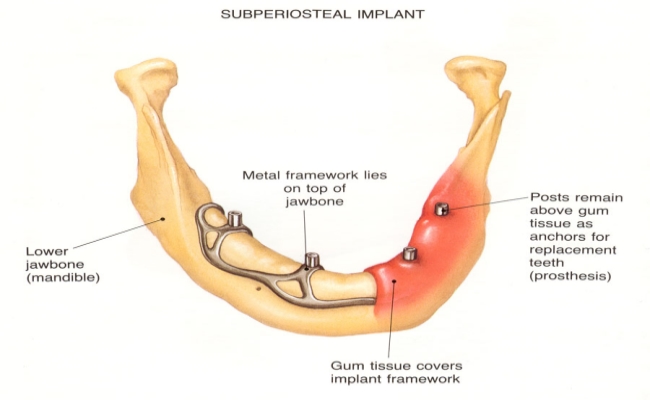
Then a custom-made titanium plate that matches the shape of your jaw bone exactly, is positioned on to the exposed upper surface of the bone.
Then the gum is positioned back in place, over the titanium plate, and stitched into place. While the gum heals up, the surface of the bone also grows into the surface of the titanium plate, and fuses to it.
After a few months, you have a solid foundation. Now you can get 4 clip attachments fitted to the titanium frame, and use these to anchor down a lower denture.
There are 2 ways to get the sub-periosteal implant made up in exactly the same shape as your jaw; the traditional way involves a preliminary surgery when the gum is numbed with local anaesthetic, peeled back to expose the jaw bone, and a small mould ("impression") is taken directly over the jaw bone.
Then the gum is stitched back into place, and the impression is sent to the dental laboratory. Here it is cast into a model of your jaw, than then a titanium plate is cast over the "surface" of your jaw, matching the shape precisely. A week or so later, you have the second stage surgery when the titanium plate is fitted under your gum.
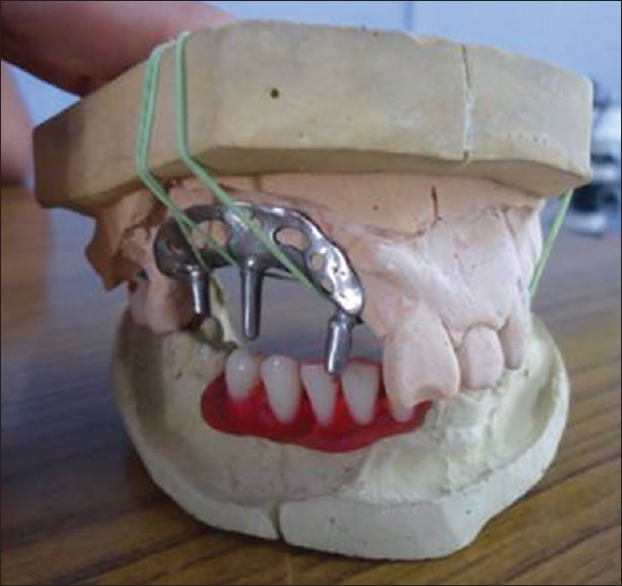 Custom made frame on a laboratory model
Custom made frame on a laboratory model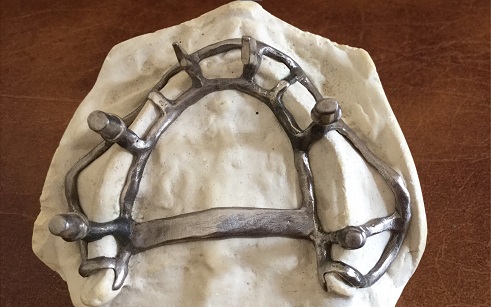 Custom made frame on a laboratory model
Custom made frame on a laboratory modelThe second, more "hi-tech" way of getting the exact shape of your jaw is to get a very high-quality CT scan of your jaw, and the jaw bone model can then be created by 3-D printing. Then the titanium implant can be cast onto the model.
This technique is a recent development, and is currently more expensive. Also, the accuracy of the fit may not be as good as the direct impression technique. But the CT scan method saves you a surgery.
Cost Of Dental Implants
A FOURTH type of dental implant is called a "plate form implant". Technically, this is also a sub-periosteal implant, but it is different to the big custom-made implant described above, because it's smaller, anti is not custom-made.
A plate form implant is used when the jaw bone is too narrow or too low for a normal root form implant. As the name suggests, the plate form implant is a flat, long implant shaped like a small flat plate which rests directly on top of the jawbone but under the gum.
Again, the gum is numbed up and then peeled back to expose the bone, in a small area of your jaw. The small flat plate implant is then positioned onto the surface of the bone (it doesn't fit the surface as precisely as the bigger sub-periosteal implant, custom-made from and impression or a CT scan). Then the gum is stitched back into place. Over the healing period, a thin layer of bone grows around the implant, and gives it a firm foundation.
Once healing is complete (3-6 months), you can get an attachment fitted to the top of the implant, which can then support new teeth. Because this implant is not custom-made and is relatively small, it cannot support the full weight of a single tooth; it's better used to support and retain a lower denture. Also, the lifespan is generally shorter than the other 3 types of dental implant.
So, those are the types of dental implant that are in current use. Your dentist or implant surgeon will decide on the best type for you after checking your X-rays and CT scan, and discussing with you your priorities. With such a variety of implant procedures available today, you are almost bound to be a good candidate for at least one of them!
Cost Of Dental Implants
- Getting Your Teeth
Generally, three to six months after your surgical dental implant procedure, your dentist can then start the process of constructing the crown or bridge that will be fitted to your new dental implants. (Dentists call this the implant superstructure).
More appointments, more of your dentist's time, more dollars. Can you start to see why dental implants cost so much?
Second, the materials and lab work are way more expensive than for a conventional crown or fixed bridge, too. The laboratory work is more demanding, needs to be more precise, and so takes up more of the technician's time.
While the lab technician's rate will not be as expensive per hour as the dentist, he may well spend MORE HOURS than the dentist working on your case. Again, more time = more $$$.
HOWEVER, if we look at the RESULTS of all this time spent by the dental professionals - what are you getting for your money? Dental implants are stronger than anything else, and will also last much longer than a conventional fixed bridge or crown. The success rate is between 95% to 98%.
The equivalent fixed bridge (fixed partial denture) will always be cheaper upfront, at the time you get it, BUT getting a bridge will involve grinding down the natural teeth on either side of the gap, to make room for the caps or crowns that hold the replacement tooth in place. Most conventional fixed bridges last about 12 to 15 years, some longer.
Then you need to get it replaced, and pay again. BUT one of the commonest reasons for a bridge failing is actually a problem with one of the supporting teeth UNDER THE BRIDGE. So this means probably having to get that problem tooth pulled, and getting a slightly bigger bridge to correct the extra missing tooth!
The cost of dental implants is higher upfront, but over a 20 or 30 year period will probably end up being the least expensive option!
Cost Of Dental Implants
Having dental implant treatment overseas is now a realistic option, and can be very cost-effective; Dentistry Abroad is certainly worth looking at and investigating. But be sure to ask ALL the questions, including how many appointments will be needed.
I recently worked for 5 years in a dental office that specialized in dental implants . I got to see the failures as well as the successes, and how dental implant costs depend on how complicated the situation is. For sure, things like bone grafting and dental sinus augmentation procedures can drive up the cost of dental implants even more.
 Two implants in the jawbone
Two implants in the jawboneCost Of Dental Implants
So let's recap - what is a dental implant?
I tell my patients that most single implants these days are like an artificial tooth root. They are usually about the size and shape of a normal tooth root. They are made of surgical-grade titanium, although Zirconia Dental Implants are also available. Ceramic dental implants cost about the same as normal titanium implants.
A dental implant replaces a tooth root that has been lost, for whatever reason. Maybe the tooth broke, or you got an abscess, and had to get it pulled. It doesn't matter too much. All you know is, you have a gap where you used to have a tooth.
When you are faced with tooth loss unexpectedly, especially a front tooth, it can be hard to know what to do. It's easy to feel pressure to make a decision one way or the other, either for an implant or for a bridge. But you don't have to make your mind up straightaway. There are a couple of possible short-term options that will buy you some time.
Sometimes a very quick "fix" is a dental flipper. This is a very small partial plate or denture that can fill the gap as a temporary measure. If you're getting an implant, a dental flipper is also ONE option to fill the gap while the implant is healing.
Another option is an adhesive bridge, sometimes called a Maryland bridge. The main advantage is that it does not require any neighboring teeth to be trimmed down for a crown, the way a conventional fixed bridge does. A Maryland bridge can be "glued" or bonded to one or two teeth next to the gap.
The disadvantage with a Maryland bridge is that it will only work if there is enough room for the little metal bonding tag to fit behind the neighboring tooth when you bite down. Also, sometimes the bond can come off, and you have to get the bridge re-fitted.
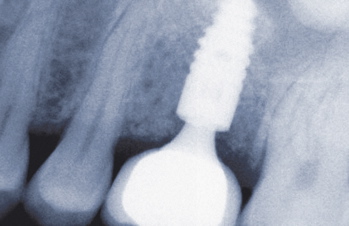 dental implant
dental implantBoth of these temporary tooth replacements will give you some time to think about whether to get a dental implant or a fixed bridge.
Your dentist has a legal obligation to explain the advantages, disadvantages, possible risks and potential benefits of both treatments. He must also explain any special conditions that may affect your particular case, for example if you smoke or have diabetes. These both increase the risk of dental implant failure.
If you DO decide to have an implant, it is important to know that the dental implant itself is roughly only about HALF of the TOTAL tooth implant cost!
A dental implant is only a tooth root. You need the replacement tooth, too. After all, the only reason to have a dental implant is to get a new tooth!
IN ADDITION, you may need a bone graft to help support the new implant, which will increase the cost of the treatment, as well as extending the overall treatment time required.
Cost Of Dental Implants
But you can't get the tooth put on the implant right away. Normally, you have to wait for a time to allow for healing. This is the healing process where the implant becomes fused to the bone. Dentists call it "osseo-integration".
So, after a dental implant has been put in, and healed up (about 3 months), your dentist has to take another mold of your teeth, including the top of the implant. Then his dental laboratory can make the Dental implant crown. This crown is then screwed or cemented onto the top of the implant.
You have to think of dental implants cost being in two bits; half for the dental implant itself (the new "tooth root"), and half for the new crown and screw system that joins it to the implant.
The advantages of dental implants are that they are very strong and are extremely unlikely to fracture. Dental implants do not decay. Getting a dental implant to replace one missing tooth means that the dentist does not have to grind down the teeth on either side of the gap, like he would for a fixed bridge.
The disadvantages of dental implants are cost and complexity. Dental implants cost more than the alternatives. The tooth implant cost for a single tooth will nearly always be about 50% more than the equivalent fixed bridge, for example.
Cost Of Dental Implants
- other issues
Dental implants can also be complicated, requiring several appointments over a period of months. Good planning and a skilled dentist are also essential to success!
Dental implant procedures are complex, and there can be issues such as;
Dental implant complications. There are a number of complications which may crop up. They usually result in the whole dental implant process taking a bit longer, but are not critical in most cases.
Dental implant infection. Any infection to do with a dental implant can be serious. Not for your general health, but for the survival of the implant itself.
Dental implant pain. Getting dental implants almost always involves a degree of discomfort afterwards, as things heal up. The degree of discomfort depends on a number of factors.
Dental implant failure. A dental implant can fail at almost any point in its lifetime, from within weeks of getting it placed to years later. Here you can find out more about possible reasons for failure.
Peri-implantitis. This is a low-grade chronic inflammation around the neck of an implant, that can slowly cause problems if it is left untreated.
Cost Of Dental Implants
Something a lot of people ask me about is Immediate Load dental implants. But you must know about the limitations! Immediate load implants are only suitable in certain situations. Dental implants should generally NOT bear any weight or load until they have fully healed and become fused to the jaw-bone.
ONE technique that recommends immediate loading is the All On 4 Dental Implant surgery technique from Nobel Biocare.
Here are my opinions on some of the top dental implant manufacturers. The dental implant industry has grown very quickly, and a lot of small companies have appeared producing dental implants that look identical to well-known established brands.
But sometimes these new implants have simply copied the existing designs, without fully understanding the reasons for certain features.
Astra Dental Implants are one of the best dental implant producers, and I recommend them.
If you are fed up with loose dentures, and want to find out how to make them stay in place reliably, take a look at denture implants, which will anchor your dentures down in place. These dental implants cost less than ones that support a fixed tooth.
There is also more information about this on the Dental Implant dentures page.
An alternative, for LOWER dentures only, Dental mini implants may be a solution! But again, make sure you know about their limitations. Dental mini implants are really only suitable for the lower jaw.
There is a slightly different viewpoint presented at Mini dental implant.
If you're interested in how dental implants came about, you can read the fascinating story at Dental implant history. It details the accidental discovery by Professor Branemark that titanium is the ideal material for dental implants, and the struggle he had to get his ideas accepted!
At the end of dental implant treatment, if everybody has done their job properly and the implant is successful, you will have a new tooth or teeth that look and feel like natural teeth. The cost of dental implants is more than the alternatives, but they will last much longer! Your own dentist will be able to advise you about the alternatives that are suitable for you.
Back to Top


